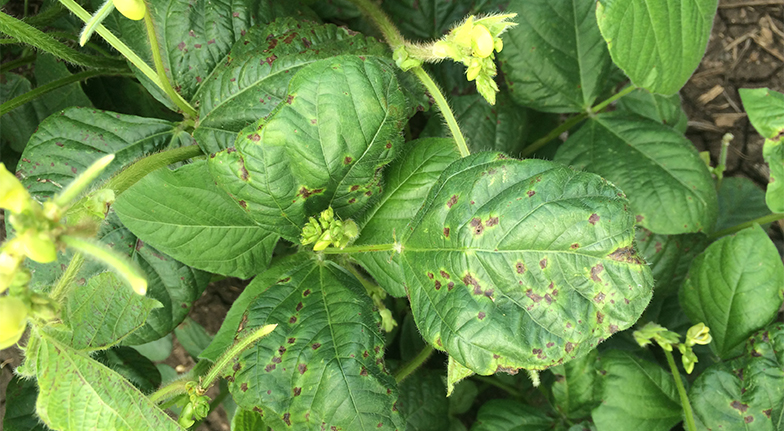Tan spot can infect seedings very early resulting in large chlorotic areas on the first and second trifoliate leaves. Photo DAF.
Clean seed reduces mungbean disease risk
Mungbean growers are encouraged to use low risk planting seed, choose varieties with higher levels of resistance and avoid paddocks with a history of disease to reduce the risk of halo blight and tan spot this summer.
The advice from Queensland Department of Agriculture and Fisheries (DAF) plant pathologist Lisa Kelly comes in the wake of years of field observations and sampling that shows disease continues to have a significant impact on mungbean yields.
Ms Kelly has been a key researcher in a collaborative Grains Research and Development Corporation (GRDC), DAF and University of Southern Queensland (USQ) disease research investment, which has provided hands-on advice for northern growers trying to avoid losses from two of the major diseases affecting mungbeans, halo blight and tan spot.
Halo blight was a major issue for mungbean growers in southern Queensland in 2015 and 2016, due to the cooler, wet start to the growing seasons. These weather conditions are less conducive to tan spot which favours warm, dry conditions, but both diseases remain an important reason for growers to source disease-free seed.
“Infected seed is thought to be the major source of infection within a crop. Only one halo blight infected seed per 10,000 is enough to produce an epidemic under the right environmental conditions.”
To reduce the risk, Ms Kelly advised growers to use Australian Mungbean Association (AMA) approved seed, which has been checked prior to harvest for disease.
“There are currently no registered chemicals for the control of halo blight and tan spot on infected plants or seed, which is why growers need to pay particular attention to crop hygiene by using clean seed and selecting paddocks wisely,” she said.

Halo blight is characterised by small, water-soaked lesions that are surrounded by a yellow-green halo on young leaves. Older lesions have less pronounced haloes with lesions visible on both sides of the leaves. Photo DAF.
Ms Kelly said the risk of a halo blight and/or tan spot could be minimised by:
1) Use low risk planting seed Avoid using seed from an infected mungbean crop. AMA approved seed is sourced from crops inspected for disease symptoms during the growing season.
2) Selecting resistant varieties Celera II-AU is rated as moderately resistant and provides the best levels of resistance to the halo blight pathogen. All other commercial varieties are either susceptible or moderately susceptible to both tan spot and halo blight, although Jade-AU and Crystal have the next best levels of resistance.
3) Crop rotation Mungbean crops should be rotated with a non-host crop, such as sorghum, chickpeas, wheat or barley for at least two years. This also allows for the breakdown of mungbean crop stubble which can also harbour both pathogens.
4) Control host weeds and volunteers Volunteer plants and weeds such as cowvine, bellvine, morning glory, tick clover and butterfly pea are known hosts of one or both diseases and should be managed effectively.
5) Restrict movement through crop Restrict movement of machinery and people through the crop to avoid spreading the disease. Harvesting equipment should also be thoroughly cleaned of mungbean residues, preferably with an antibacterial solution, to avoid spreading the bacteria.
Ms Kelly said halo blight was characterised by small, water-soaked lesions that are surrounded by a yellow-green halo on young leaves. Infected seedlings typically survive and become the major source of inoculum for later infection in the crop. Older lesions have less pronounced haloes with lesions visible on both sides of leaves.
Tan spot (also known as bacterial scorch and wilt) can infect seedings very early resulting in large chlorotic areas on the first and second trifoliate leaves. As the seedlings grow, they can wilt and die rapidly. Surviving seedlings are often stunted and are the major sources of inoculum for later infection in the crop. Leaves on older plants develop a scorched appearance, with interveinal necrotic lesions surrounded by a distinct chlorotic margin and when subject to windy conditions this dead leaf material can tear away giving the plant a ratty appearance.
“If growers or advisers are unsure about identifying these diseases, they can send photos or samples directly to me for confirmation,” Ms Kelly said.
Samples should be sent via courier or express post to Lisa Kelly, DAF, 203 Tor St, Toowoomba, Queensland 4350. Please call Lisa on 0477 747 040 or email lisa.kelly@daf.qld.gov.au prior to sending samples. Source: GRDC
Read Pulse Check blog articles | Pulse Check Coastal facebook | Subscribe to the monthly newsletter

